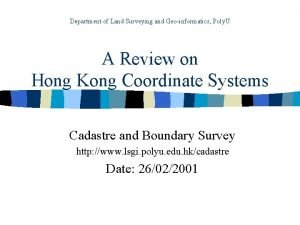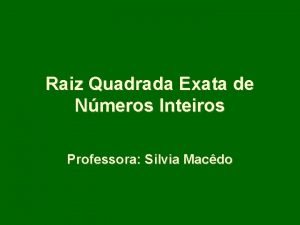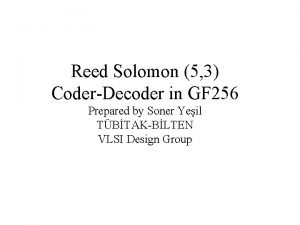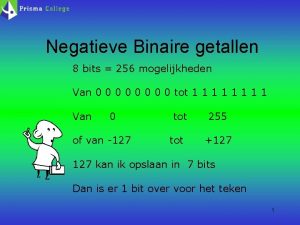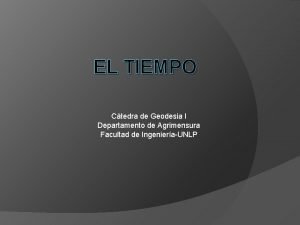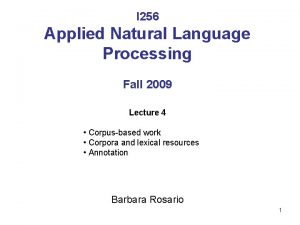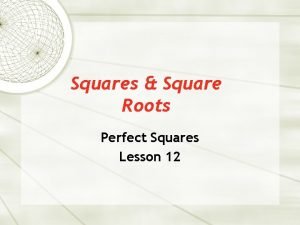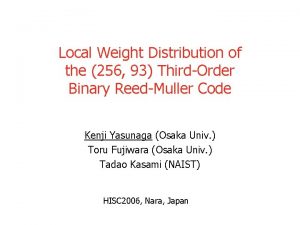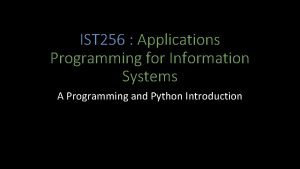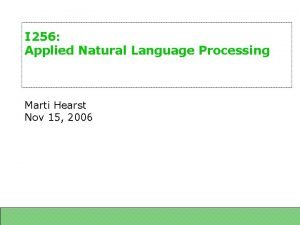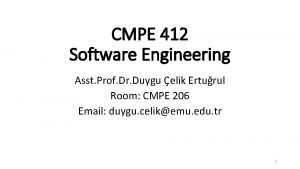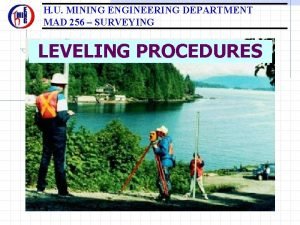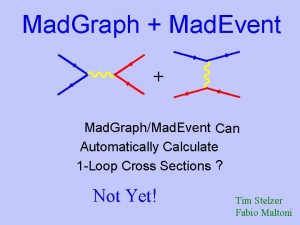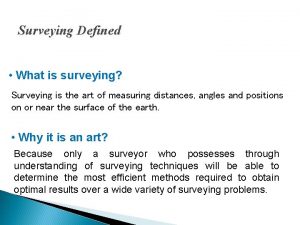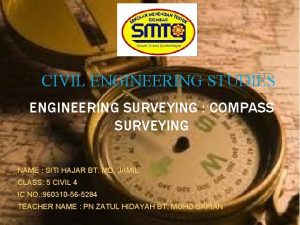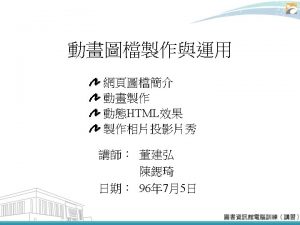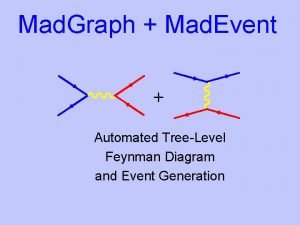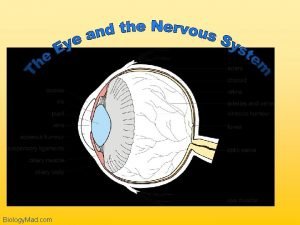H U MINING ENGINEERING DEPARTMENT MAD 256 SURVEYING


























- Slides: 26

H. U. MINING ENGINEERING DEPARTMENT MAD 256 – SURVEYING BASICS OF TRAVERSING

What is a traverse? • A polygon of 2 D (or 3 D) vectors • Sides are expressed as either polar coordinates ( , d) or as rectangular coordinate differences ( E, N) • A traverse must either close on itself • Or be measured between points with known rectangular coordinates A closed traverse A traverse between known points

Applications of traversing • Establishing coordinates for new points (E, N)known d) ( , (E, N)known ( ( , d) (E, N)new ) d , (E, N)new

Applications of traversing • These new points can then be used as a framework for mapping existing features (E, N)known (E, N)new ) ( , d) , d) ( ) d) ( , d , ( , d ( ) (E, N)new ( , d (E, N)new (E, N)known

Applications of traversing • They can also be used as a basis for setting out new work (E, N)known (E, N)new

Equipment • Traversing requires : n n An instrument to measure angles (theodolite) or bearings (magnetic compass) An instrument to measure distances (EDM or tape)

Measurement sequence C o 2 o 168 32 60. 63 o 205 o 352 B o 56 . 92 9 9 o 77. 19 2 23 21 o 9. 2 1 . 20 o 8 11 32 A 30 o o 3 E 48 76 D

Computation sequence 1. Calculate angular misclose 2. Adjust angular misclose 3. Calculate adjusted bearings 4. Reduce distances for slope etc… 5. Compute ( E, N) for each traverse line 6. Calculate linear misclose 7. Calculate accuracy 8. Adjust linear misclose

Calculate internal angles Point Foresight Backsight Azimuth Internal Angle A 21 o 118 o 97 o B 56 o 205 o 149 o C 168 o D 232 o E 303 o =(n-2)*180 Misclose Adjustment Adjusted Angle o o 232 64 At each point : • o. Measure foresight azimuth 352 120 o • Meaure backsight azimuth o • o Calculate 105 internal angle (back-fore) 48 For example, at B : • Azimuth to C = 56 o • Azimuth to A = 205 o • Angle at B = 205 o - 56 o = 149 o

Calculate angular misclose Point Foresight Backsight Azimuth Internal Angle A 21 o 118 o 97 o B 56 o 205 o 149 o C 168 o 232 o 64 o D 232 o 352 o 120 o E 303 o 48 o 105 o =(n-2)*180 535 o Misclose -5 o Adjustment -1 o Adjusted Angle

Calculate adjusted angles Point Foresight Backsight Azimuth Internal Angle Adjusted Angle A 21 o 118 o 97 o 98 o B 56 o 205 o 149 o 150 o C 168 o 232 o 64 o 65 o D 232 o 352 o 120 o 121 o E 303 o 48 o 105 o 106 o 535 o 540 o =(n-2)*180 Misclose -5 o Adjustment -1 o

Compute adjusted azimuths • Adopt a starting azimuth • Then, working clockwise around the traverse : n n n Calculate reverse azimuth to backsight (forward azimuth 180 o) Subtract (clockwise) internal adjusted angle Gives azimuth of foresight • For example (azimuth of line BC) n n Adopt azimuth of AB 23 o Reverse azimuth BA (=23 o+180 o) Internal adjusted angle at B 150 o Forward azimuth BC (=203 o-150 o)53 o 203 o

Compute adjusted azimuths C o 53 B 203 o 150 o D Line Forward Azimuth Reverse Azimuth Internal Angle AB 23 o 203 o 150 o BC 53 o CD DE EA A E AB

Compute adjusted azimuths C o D 23 o Forward Azimuth Reverse Azimuth Internal Angle AB 23 o 203 o 150 o BC 53 o 233 o 65 o CD 168 o o B 65 o 168 2 33 Line DE EA A E AB

Compute adjusted azimuths C o Forward Azimuth Reverse Azimuth Internal Angle AB 23 o 203 o 150 o BC 53 o 233 o 65 o CD 168 o 348 o 121 o DE 227 o o 121 o 23 o B 348 53 Line o 7 22 D EA A E AB

Compute adjusted azimuths C o B 23 o D o 47 A 106 o o 1 30 E Forward Azimuth Reverse Azimuth Internal Angle AB 23 o 203 o 150 o BC 53 o 233 o 65 o CD 168 o 348 o 121 o DE 227 o 47 o 106 o o 168 53 Line EA AB -59 o 301 o

Compute adjusted azimuths C o B 23 o D o 98 o A o 1 12 E Forward Azimuth Reverse Azimuth Internal Angle AB 23 o 203 o 150 o BC 53 o 233 o 65 o CD 168 o 348 o 121 o DE 227 o 47 o 106 o EA 301 o 121 o 98 o AB 23 o (check) o 168 53 Line 7 22

( E, N) for each line • The rectangular components for each line are computed from the polar coordinates ( , d) • Note that these formulae apply regardless of the quadrant so long as whole circle bearings are used

Vector components Line Azimuth Distance E N AB 23 o 77. 19 30. 16 71. 05 BC 53 o 99. 92 79. 80 60. 13 CD 168 o 60. 63 12. 61 -59. 31 DE 227 o 129. 76 -94. 90 -88. 50 EA 301 o 32. 20 -27. 60 16. 58 (399. 70) (0. 07) (-0. 05)

Linear misclose & accuracy • Convert the rectangular misclose components to polar coordinates Beware of quadrant when calculating using tan-1 • Accuracy is given by

For the example… • Misclose ( E, N) n (0. 07, -0. 05) • Convert to polar ( , d) n n = -54. 46 o (2 nd quadrant) = 125. 53 o d = 0. 09 m • Accuracy n 1: (399. 70 / 0. 09) = 1: 4441

Bowditch adjustment • The adjustment to the easting component of any traverse side is given by : Eadj = Emisc * side length/total perimeter • The adjustment to the northing component of any traverse side is given by : Nadj = Nmisc * side length/total perimeter

The example… • • East misclose 0. 07 m North misclose – 0. 05 m Side AB 77. 19 m Side BC 99. 92 m Side CD 60. 63 m Side DE 129. 76 m Side EA 32. 20 m Total perimeter 399. 70 m

Vector components Side E N AB 30. 16 71. 05 BC 79. 80 60. 13 CD 12. 61 -59. 31 DE -94. 90 -88. 50 EA -27. 60 16. 58 Misc (0. 07) (-0. 05) d E (pre-adjustment) d N Eadj Nadj

The adjustment components Side E N d E AB 30. 16 71. 05 0. 014 -0. 010 BC 79. 80 60. 13 0. 016 -0. 012 CD 12. 61 -59. 31 0. 011 -0. 008 DE -94. 90 -88. 50 0. 023 -0. 016 EA -27. 60 16. 58 0. 006 -0. 004 (-0. 05) (0. 070) (-0. 050) Misc (0. 07) d N Eadj Nadj

Adjusted vector components Side E N d E d N Eadj Nadj AB 30. 16 71. 05 0. 014 -0. 010 30. 146 71. 060 BC 79. 80 60. 13 0. 016 -0. 012 79. 784 60. 142 CD 12. 61 -59. 31 0. 011 -0. 008 12. 599 -59. 302 DE -94. 90 -88. 50 0. 023 -0. 016 -94. 923 -88. 484 EA -27. 60 16. 58 0. 006 -0. 004 -27. 606 16. 584 (-0. 05) 0. 070 -0. 050 Misc (0. 07) (0. 000)
 Hk 1980 grid
Hk 1980 grid Strip mining vs open pit mining
Strip mining vs open pit mining Chapter 13 mineral resources and mining
Chapter 13 mineral resources and mining Difference between strip mining and open pit mining
Difference between strip mining and open pit mining Text and web mining
Text and web mining Mining multimedia databases
Mining multimedia databases Mining complex data types
Mining complex data types Classification of surveying
Classification of surveying Raiz decima de 1024
Raiz decima de 1024 Resolución 256 de 2018
Resolución 256 de 2018 Lanczos
Lanczos There is no compulsion in religion
There is no compulsion in religion 387 en yakın yüzlüğe yuvarlama
387 en yakın yüzlüğe yuvarlama 128+64+16
128+64+16 Gf 256
Gf 256 8 bit 256
8 bit 256 Astd inf meta
Astd inf meta El año sideral dura 365. 256 días solares medios
El año sideral dura 365. 256 días solares medios Vlookup reference error 256 columns
Vlookup reference error 256 columns I^256
I^256 Is 256 a perfect square
Is 256 a perfect square 256+93
256+93 Ist 256
Ist 256 I^256
I^256 Sha 256
Sha 256 Alas sebuah limas berbentuk persegi dengan luas 256
Alas sebuah limas berbentuk persegi dengan luas 256 Cmpe 256
Cmpe 256
